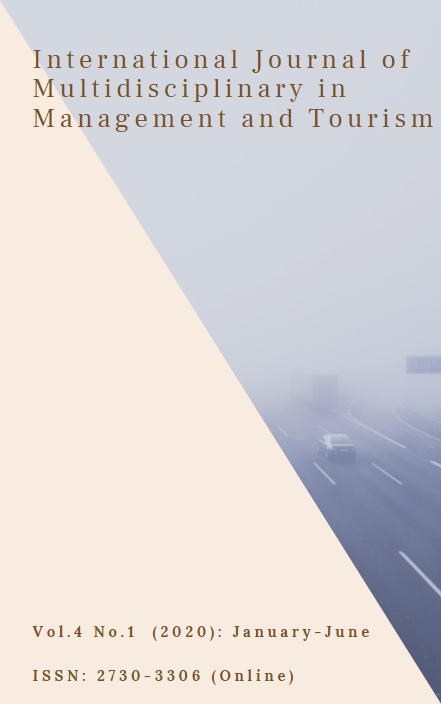Enriching the Hostel Customer Behavioral Study
Main Article Content
Abstract
The extant literature review is abundantly rich with how customers perceive and respond attitudinally, behaviorally and emotionally to their hotel experiences. It is, nevertheless, not so fortunate in the hostel context. In closing this gap this study employs the theoretical concept of stimulus-organism-response (SOR). The 250 valid responses of the questionnaire survey were used to operate the structural equation modeling (SEM) analysis. The SOR concept was developed using a mix of literature review and interviews. The latter contributes, in particular, when there is a lack of information, and has prompted the study to focus on the stimulation variables involving service operations (both tangible and intangible aspects), the social engagement environment (which is a differentiating feature of hostels), and hostel brand to influence the value and hostel brand image perceptions of the customers, which in turn, influence how they would engage in social media and as loyal customers.
Article Details
References
Baruch, Y., and Holtom, B. (2008). Survey Response Rate Levels and Trends in Organizational Research. Human Relations 61(8), 1139-1160.
Bettman, J.R. (1970). Information Processing Models of Consumer Behavior. Journal of Marketing Research, 7(3), 370-376.
Cropanzano, R. & and Mitchell, M.S. (2005). Social Exchange Theory: An Interdisciplinary Review. Journal of Management, 31(6), 874-900.
Crosby, L.A., Evans, K.R. & Cowles, D. (1990). Relationship Quality in Services Selling: An Interpersonal Influence Perspective. Journal of Marketing, 54(3), 68-81.
Dirsehan, T., & Kurtuluş, S. (2018). Measuring Brand Image Using a Cognitive Approach: Representing Brands as a Network in the Turkish Airline Industry. Journal of Air Transport Management, 67, 85-93.
Eysenck, M. W., Keane, M. (2000). Cognitive Psychology: A Student's Handbook. England: Psychology Press.
Forza, C. (2002). Survey Research in Operations Management: A Process-Based Perspective. International Journal of Operations & Production Management, 22(2), 152-194.
Gligor, D., Bozkurt, S. & Russo, I. (2019). Achieving Customer Engagement with Social Media: A Qualitative Comparative Analysis Approach. Journal of Business Research, 101, 59-69.
Gomez, M, Lopez, C. & Molina, A. (2019). An Integrated Model of Social Media Brand Engagement. Computers in Human Behavior, 96, 196-206.
Goyder, J. (1985). Nonresponse Effects on Relationships between Variables. Public Opinion Quarterly, 40, 360–369.
Hair, J.F., Black, W.C., Babin, B.J. & Anderson. R. E. (2014). Pearson New International Edition: Multivariat Data Analysis. (7th ed.). London: Pearson.
Han, H., Kim, Y. & Kim, E. (2011). Cognitive, Affective, Conative, And Action Loyalty: Testing the Impact of Inertia. International Journal of Hospitality Management, 30(4), 1008-1019.
Heelworks. (2018). Southeast Asia Hostel Market Update. Bangkok: Heelworks.
Holbrook, M.B., Lehmann, D.R. & O'Shaughnessy, J. (1986). Using Versus Choosing: The Relationship of the Consumption Experience to Reasons for Purchasing. European Journal of Marketing, 20(8), 49-62.
Hostelworldgroup. (2019). Hostel world Unveils its ‘Evolution of the Hostel Traveller’ Report. Retrieved from http://www.hostelworldgroup.com/~/media/Files/H/Hostel world-v2/press-release/pr-hostelworld-unveils-its-evolution-of-the-hostel-traveller-report.pdf.
Huang, C. & Liu, C. (2018). The Creative Experience and its Impact on Brand Image and Travel Benefits: The Moderating Role of Culture Learning. Tourism Management Perspectives, 28, 144-155.
Jani, D. & Han, H. (2015). Influence of Environmental Stimuli on Hotel Customer Emotional Loyalty Response: Testing the Moderating Effect of the Big Five Personality Factors. International Journal of Hospitality Management, 44, 48-57.
Kaplan, A.M. & Haenlein, M. (2010). Users of The World, Unite! The Challenges and Opportunities of Social Media. Business horizons, 53(1), 59-68.
Kenny, D.A., and McCoach, D. B. (2003). Effect of the Number of Variables on Measures of Fit in Structural Equation Modeling. Structural Equation Modeling, 10(3), 333-351.
Kihlstrom, J. F. (1987). The Cognitive Unconscious. Science, 237(4821), 1445-1452.
Kim, H. & Lennon, S. (2010). E-Atmosphere, Emotional, Cognitive, and Behavioral Responses. Journal of Fashion Marketing and Management, 14(3), 412-428.
Kungsri Research. (2017). Hotel industry outlook 2018-2020.Thailand: Krungsri .
Mehrabian, A. & Russell, J.A. (1974). An approach to Environmental Psychology. Massachusetts: MIT Press.
Moital, M. (2007). An Evaluation of the Factors Influencing the Adoption of E-Commerce in the Purchasing of Leisure Travel by the Residents of Cascais, Portugal(Ph.D. Dissertations). Bournemouth University.
Nasution, H. N. & Mavondo, F.T. (2008). Customer Value in the Hotel Industry: What Managers Believe They Deliver and What Customer Experience. International Journal of Hospitality Management, 27(2), 204-213.
Newell, A., Shaw, J. & Simon, H. (1958). Elements of a Theory of Human Problem Solving. Psychological Review, 65(3), 151-166.
Oliver, R.L. (1999). Whence Consumer Loyalty?. Journal of Marketing, 63. (4sl1), 33-44.
Ribeaux, P. & Poppleton, S.E. (1978). Psychology and Work: An introduction. UK: Macmillan International Higher Education.
Salvatore, D. (2008). Microeconomics: Theory & Applications. USA: Oxford University Press.
Skinner, B. F. (1938). The Behavior of Organisms: An Experimental Analysis. New York: Appleton-Century-Crofts.
Stewart, J.P. (1994).The Psychology of Decision Making. In D. Jennings and S. Wattam (Eds.). Decision making: An integrated Approach. London: Pitman.
Tan, C.C. & Apisit-Isariyah, P. (2018). Towards A Community-Based Theory of Brand Community Engagement. Advanced Science Letters 24(7), 5167-5170.
Tan, C.C. (2019). A Hierarchical Stimulus-Organism-Response Framework of Tourist Perceptions for Community-As-Brand Development. The First ICRU International Conference on World Sustainable Development (WSD 2019). Feb 18-20, 89-95.
Tan, C.C. (2019). Intercepting Stimulus-Organism-Response Model, Theory of Planned Behavior and Theory of Expectancy Confirmation in the Study of Smartphone Consumer Behavior: A Thai University Student Perspective. Asia Pacific Journal of Religions and Cultures, 3(2), 27-48.
Tan, C.C., Phakeephirot, N. & Sereewichayaswat, W. (2019). Fieldtrip Advantages for Tourism Students: Contributing towards Hierarchical Aspect of the Stimulus-Organism-Response (S-O-R) Theory. Dusit Thani College Journal, 13, 3.
Timothy, D. & Teye, V. (2009). Tourism and the Lodging Sector. London: Routledge.
Tiu, W.L., Newman, A. & Dennis, C. (2006). Enhancing Consumer Empowerment. European Journal of Marketing, 40(9/10), 925-935.
Vieira, V. (2013). Stimuli–Organism-Response Framework: A Meta-Analytic Review in the Store Environment. Journal of Business Research, 66(9), 1420-1426.
Zajonc, R. B. (1980). Feeling and Thinking: Preferences Need No Inferences. American Psychologist, 35(2), 151.
Zajonc, R. B. (1984). On the Primacy of Affect. American Psyclzologist, 39(1), 17-123.
Zeithaml, V.A. & Bitner, M. (1996). Services Marketing. Malaysia: McGraw-Hill.

